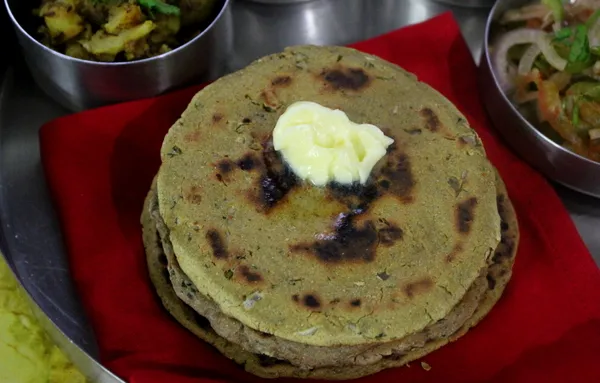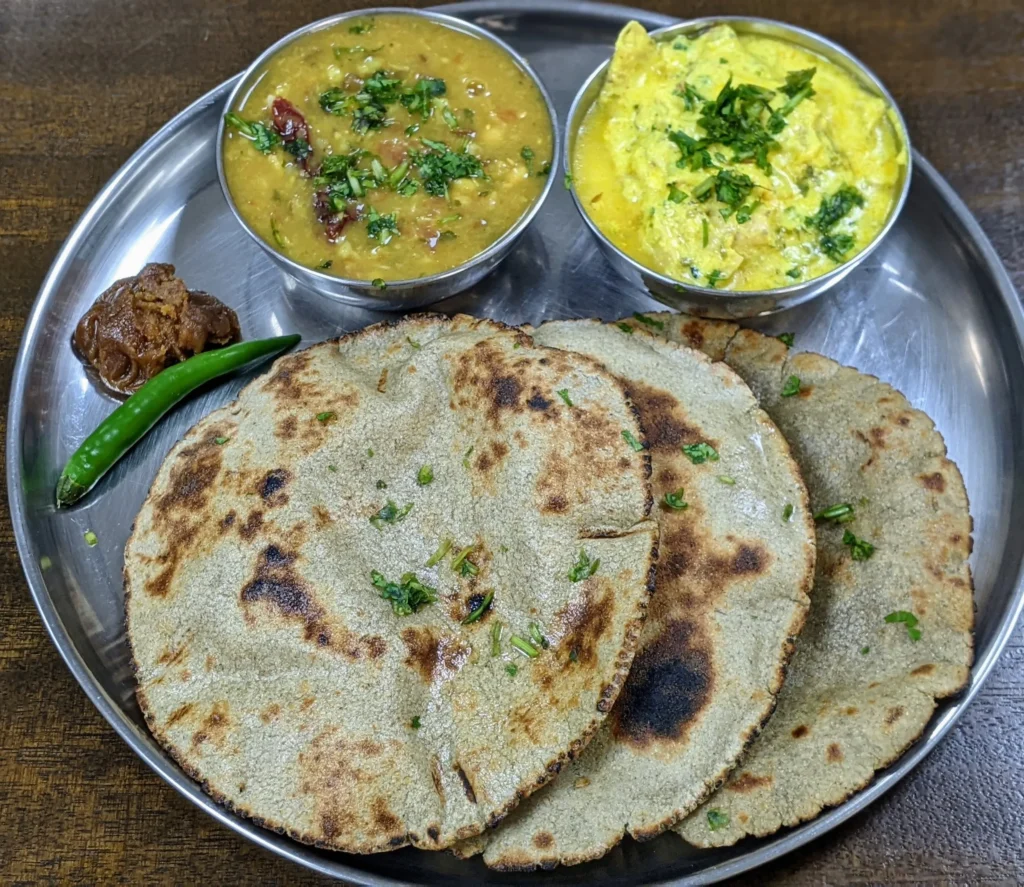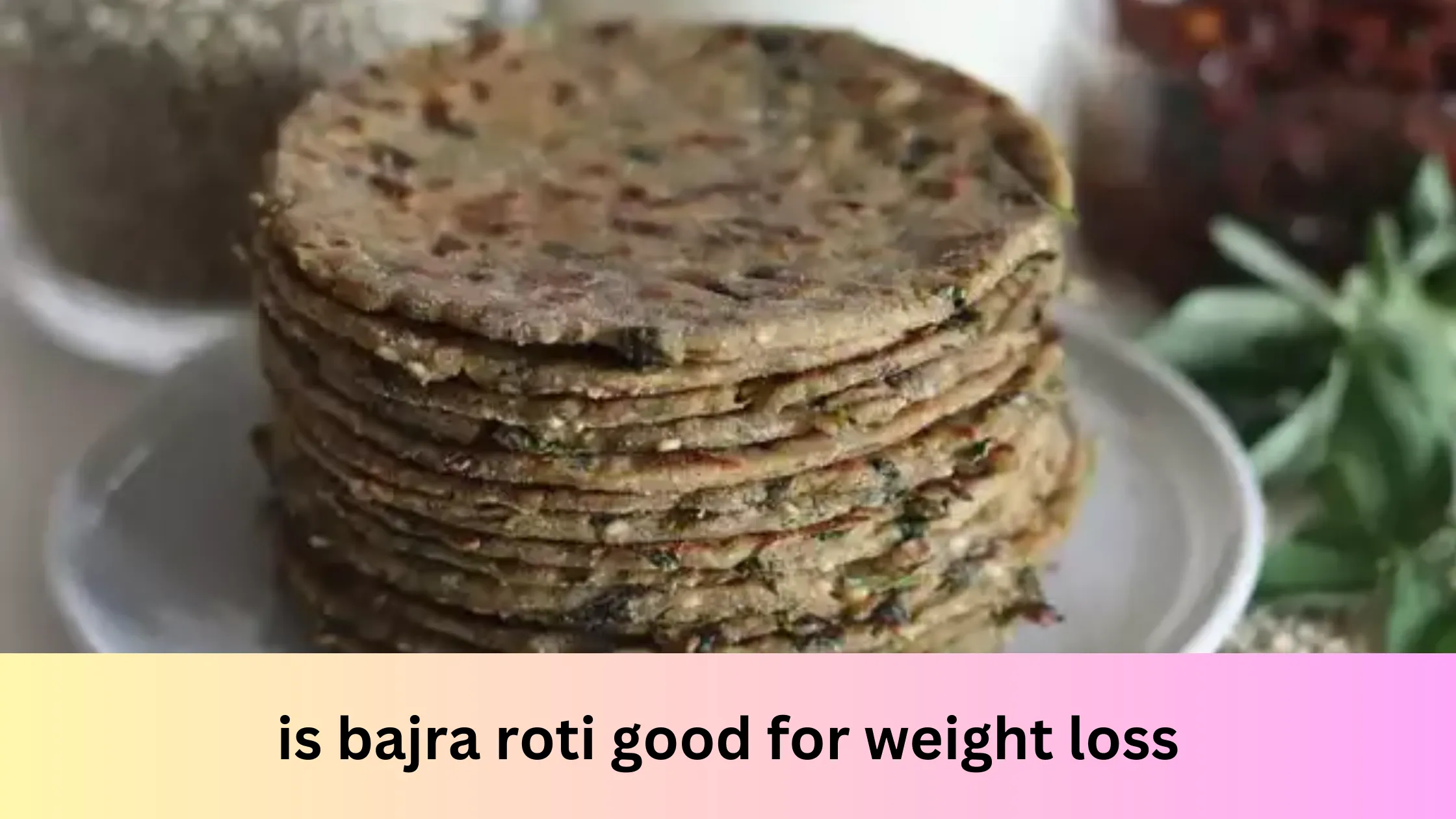In the world of health and fitness, people are always on the lookout for foods that can help them lose weight without sacrificing flavor or nutrition. Among the many options, bajra roti, a traditional Indian flatbread made from pearl millet flour, has started gaining attention as a weight-loss-friendly food. But is it really as beneficial as some claim, or is it just another health trend that’s being hyped up?
Bajra has been a staple in Indian households for centuries, especially in rural areas where it’s known for its ability to keep people full and energized. However, in recent years, this humble grain has entered the spotlight as more people discover its impressive nutritional value. Packed with fiber, protein, and essential minerals, bajra is now being recognized as a superfood that could aid weight loss.
But let’s take a step back. Weight loss isn’t just about eating so-called “superfoods.” It’s about making sustainable dietary choices that work for your body and lifestyle. So, where does bajra roti fit into this picture? Can it really support your weight loss journey, or is it just another trendy food with exaggerated claims?
In this blog post, we’ll dig into the truth behind bajra roti and its role in weight loss. By the end, you’ll know whether this traditional flatbread deserves a spot in your diet or if it’s just another fad to be cautious about. Let’s get started!
What Is Bajra Roti?
Bajra roti is a traditional Indian flatbread made from bajra, which is also known as pearl millet. Bajra is a type of whole grain that has been a staple in Indian kitchens for centuries, especially in rural areas. This millet thrives in dry, arid regions and is often considered a superfood because of its impressive nutritional benefits.
The process of making bajra roti is simple but unique. The dough is prepared by mixing bajra flour with water, and sometimes a pinch of salt is added for flavor. Unlike wheat dough, bajra dough doesn’t have gluten, which means it’s not as stretchy or pliable. This makes it a little trickier to roll out, but it’s worth the effort! Many people shape the roti by hand instead of using a rolling pin. It’s then cooked on a tawa (flat pan) until it’s soft and slightly crispy on the outside.
Bajra roti has a dense, earthy flavor and a hearty texture that pairs well with a variety of dishes. It’s often served with curries, lentils, or even a dollop of ghee (clarified butter) to enhance its taste. In many parts of India, it’s considered comfort food and is often eaten during the winter months because bajra is known to keep the body warm.

From a nutritional perspective, bajra roti is packed with fiber, protein, and essential minerals like iron, magnesium, and potassium. It’s also naturally gluten-free, making it a great option for people who are sensitive to gluten or those looking for a healthier alternative to wheat-based rotis.
In recent years, bajra roti has gained popularity beyond traditional households, especially among health-conscious individuals and those on weight-loss journeys. Its rich nutrient profile, combined with its ability to keep you feeling full for longer, has made it a star in many modern diets.
In short, bajra roti is much more than just a flatbread. It’s a nutritious, wholesome food that has stood the test of time—and is now making a well-deserved comeback in the world of healthy eating!
Benefits of Bajra Roti for Weight Loss
Bajra roti, made from pearl millet flour, has become a favorite in many weight-loss diets, and for good reason. This humble, nutrient-rich flatbread offers a range of benefits that can support your journey to shed those extra pounds. Let’s break down why bajra roti deserves a spot on your plate:
1. High in Fiber: Keeps You Full Longer
One of the biggest challenges during weight loss is dealing with hunger pangs and cravings. Bajra roti is packed with dietary fiber, which slows down digestion and keeps you feeling full for a longer time. This reduces the temptation to snack on unhealthy foods and helps you stick to your calorie goals.
Think of it like this: when you eat bajra roti, it works as a natural appetite suppressant, making it easier to control portion sizes and maintain a calorie deficit.
2. Low Glycemic Index: Stable Blood Sugar Levels
Bajra has a low glycemic index, meaning it releases sugar into your bloodstream gradually instead of causing sudden spikes. Why does this matter for weight loss? Stable blood sugar levels prevent energy crashes and reduce cravings for sugary or carb-loaded snacks.
By replacing regular wheat rotis or rice with bajra roti, you can keep your energy steady throughout the day while avoiding those “hangry” moments.
3. High in Protein: Boosts Metabolism
Protein is an essential nutrient for weight loss because it helps build and repair muscles while boosting your metabolism. Bajra is surprisingly rich in plant-based protein, which supports muscle health and increases the number of calories your body burns even at rest.
Including bajra roti in your meals ensures you’re not just cutting calories but also fueling your body with what it needs to stay strong and active.
4. Naturally Gluten-Free: Ideal for Sensitive Diets
If you’re sensitive to gluten or following a gluten-free diet, bajra roti is a fantastic alternative to wheat-based options. Many people with gluten sensitivities notice less bloating and feel lighter when they switch to gluten-free foods.
Less bloating can make you feel more comfortable and motivated as you work towards your weight-loss goals.
5. Packed with Essential Nutrients
Weight loss isn’t just about cutting calories—it’s about nourishing your body too. Bajra roti is rich in essential nutrients like magnesium, iron, and B vitamins. These nutrients support your overall health and ensure that your body functions optimally during your weight-loss journey.
For example:
- Magnesium aids in energy production and helps with better sleep.
- Iron keeps your energy levels up by promoting healthy blood circulation.
- B vitamins help your body convert food into energy efficiently.
When your body gets the nutrition it needs, you’ll feel more energetic and less likely to give in to unhealthy cravings.
6. Aids Digestion
The high fiber content in bajra roti not only keeps you full but also promotes good digestion. Proper digestion plays a key role in weight loss by preventing issues like bloating, constipation, or sluggish metabolism. A happy gut often means a healthier body!
How to Maximize the Benefits
While bajra roti has plenty of benefits, remember that no single food can do it all. Combine bajra roti with nutrient-rich side dishes like leafy greens, lentils, or low-fat yogurt for a balanced meal. And don’t forget portion control—eating too much of anything, even healthy food, can slow down your progress.
In short, bajra roti is not just a healthy flatbread; it’s a weight-loss-friendly powerhouse. By keeping you full, balancing your blood sugar, and providing essential nutrients, it helps you stay on track with your goals without compromising on taste or health. So, go ahead and give it a try!
Read Also: Haldiram Moong Dal: Weight Loss Friendly or Not?
Potential Drawbacks or Limitations of Bajra Roti
While bajra roti is packed with health benefits and often celebrated as a weight-loss-friendly food, it’s not without its drawbacks. Like any other food, it has limitations that need to be considered before making it a staple in your diet. Let’s take a closer look at some of the potential downsides:
1. May Cause Bloating or Digestive Issues
Bajra is high in fiber, which is great for keeping you full and supporting digestion. However, consuming too much fiber at once can sometimes lead to bloating, gas, or discomfort, especially if your body isn’t used to a high-fiber diet. This is why it’s essential to ease into eating bajra roti regularly and pair it with plenty of water to help your digestive system process the fiber efficiently.
2. Could Be Heavy for People with Sensitive Digestion
Bajra roti is dense and slightly heavier than wheat or rice-based foods. For individuals with sensitive stomachs or those recovering from illnesses, it might feel a bit harder to digest. If you’re prone to acidity or have a weak digestive system, it’s a good idea to eat bajra roti in smaller portions and avoid it at night, as digestion naturally slows down later in the day.
3. Unsuitable for Certain Medical Conditions
Bajra contains a significant amount of phosphorus and potassium, which are generally healthy nutrients. However, for people with kidney issues or those advised to limit these minerals in their diet, bajra may not be the best option. Additionally, its high fiber content might not suit people with inflammatory bowel conditions like IBS (Irritable Bowel Syndrome).
4. Not Ideal for Quick Energy Needs
Bajra has a low glycemic index, which is excellent for managing blood sugar levels. However, this means it releases energy slowly, making it less ideal for people needing quick energy boosts, such as athletes before a workout. If you rely on quick-burning carbs to fuel physical activity, bajra roti may not be the best pre-workout choice.
5. Overeating Can Still Lead to Weight Gain
It’s easy to fall into the trap of thinking that “healthy” foods can be eaten in unlimited quantities. While bajra roti is packed with nutrients, eating too much can still lead to weight gain because it contains calories like any other food. Portion control is key—stick to 1-2 rotis per meal and balance it with plenty of vegetables, lean protein, or a light curry.
6. Seasonal Availability and Storage
Bajra flour tends to spoil faster than wheat or other grains, especially in humid climates. It’s best to buy it in small quantities and store it in an airtight container to avoid it going rancid. Additionally, bajra is often consumed in winter because of its warming properties, and some people may find it too heavy for summer meals.
By understanding these potential drawbacks, you can make informed decisions about how and when to include bajra roti in your diet. The key is moderation and balance—listen to your body and adapt based on your individual needs and lifestyle.
How to Incorporate Bajra Roti in Your Weight Loss Diet

Bajra roti is not just nutritious; it’s also versatile, making it easy to include in your weight loss journey. Here’s how you can add this superfood to your diet in simple and effective ways:
1. Pair It with Low-Calorie, Nutrient-Dense Foods
Bajra roti can be a wholesome base for your meal, but what you pair it with matters. To keep your weight loss goals on track, combine it with:
- Vegetable Curries: Opt for light, non-creamy vegetable curries like spinach (palak), mixed vegetables, or dal. These add essential nutrients without loading up on calories.
- Salads: A side of fresh cucumber, tomato, and onion salad with a dash of lemon can complement bajra roti beautifully.
- Low-Fat Yogurt: Bajra roti tastes great with plain low-fat yogurt, which adds protein and keeps your digestion healthy.
2. Focus on Portion Control
Even though bajra roti is healthy, overeating it can hinder weight loss. Stick to 1–2 rotis per meal, depending on your calorie needs and activity level. Remember, it’s not just about what you eat but also how much you eat.
3. Make It a Part of a Balanced Meal
Don’t rely on bajra roti alone for your nutrition. Pair it with a variety of foods to ensure your body gets all the essential vitamins, minerals, and macronutrients. For example:
- A typical meal could include 1 bajra roti, a cup of dal, a bowl of steamed veggies, and a small serving of salad.
- For breakfast, pair bajra roti with a boiled egg or a scoop of cottage cheese (paneer) for added protein.
4. Experiment with Bajra Roti Recipes
Eating plain bajra roti every day can get boring. Keep it exciting by trying different variations, such as:
- Stuffed Bajra Roti: Fill it with low-calorie stuffing like grated carrots, spinach, or mashed lentils.
- Multigrain Bajra Roti: Mix bajra flour with other healthy flours like jowar or ragi for added benefits.
- Spiced Bajra Roti: Add spices like cumin, coriander, or ajwain (carom seeds) to the dough for extra flavor and digestion-friendly properties.
5. Choose the Right Time to Eat Bajra Roti
Bajra roti is ideal for lunch or dinner. Its high fiber content can keep you feeling full for longer, reducing the temptation to snack on unhealthy foods. However, avoid eating it late at night if you have digestion issues, as bajra takes longer to digest than wheat.
6. Keep It Simple and Homemade
While bajra roti is available in some restaurants or packaged as ready-to-eat products, it’s best to make it fresh at home. Store-bought options might contain extra fats, preservatives, or additives that can sabotage your weight loss.
7. Hydrate Well
Bajra is rich in fiber, which is great for weight loss but can sometimes cause bloating if you’re not drinking enough water. Make sure you’re staying hydrated throughout the day to help your body process the fiber effectively.
8. Rotate It with Other Healthy Grains
While bajra is excellent, eating the same thing every day might lead to monotony or nutrient imbalances. Rotate bajra roti with other healthy options like jowar roti, ragi roti, or whole wheat roti to enjoy a variety of nutrients.
By following these tips, you can enjoy bajra roti as a delicious, satisfying, and effective addition to your weight loss diet. Just remember: it’s not a magic food, but when combined with a balanced diet and active lifestyle, it can be a game-changer for your health!
Bajra Roti vs Other Rotis for Weight Loss
When it comes to rotis, there’s no shortage of options—bajra, whole wheat, jowar, ragi, and even multigrain rotis are all popular choices. But which one is truly the best for weight loss? Let’s break it down.
Bajra Roti
Bajra roti is made from pearl millet, which is a powerhouse of nutrients. It’s rich in dietary fiber, protein, and essential minerals like magnesium, iron, and zinc. Here’s why it stands out for weight loss:
- Keeps You Full Longer: The high fiber content in bajra roti slows digestion, making you feel full for hours. This helps reduce unnecessary snacking.
- Low Glycemic Index (GI): Bajra roti releases sugar into the bloodstream slowly, which means fewer insulin spikes. This is great for fat burning and helps prevent weight gain.
- Boosts Metabolism: Bajra is loaded with B vitamins and magnesium, which can improve energy levels and metabolism.
However, bajra roti has a dense texture and can feel heavier compared to other rotis. For some, this might take time to get used to.
Whole Wheat Roti
Whole wheat roti is the go-to choice for most households, and it’s definitely a healthy option. It’s rich in fiber and carbs, which provide sustained energy. For weight loss:
- Good Fiber Content: It helps with digestion and prevents overeating.
- Lower Calorie Count: A typical whole wheat roti has fewer calories compared to bajra roti.
- Easier to Digest: Whole wheat is lighter on the stomach and easier for most people to digest.
That said, whole wheat flour has a slightly higher glycemic index compared to bajra, which means it might not keep you full for as long.
Jowar Roti
Jowar roti, made from sorghum, is another popular choice. It’s gluten-free and has a similar nutritional profile to bajra roti. For weight loss:
- Rich in Fiber: Like bajra, jowar helps with satiety and promotes a healthy gut.
- Low Glycemic Index: Jowar releases energy slowly, making it ideal for weight management.
- High in Antioxidants: Jowar is loaded with antioxidants, which can aid in overall health and fat metabolism.
Jowar rotis are lighter than bajra rotis and easier for some people to incorporate into their meals.
Ragi Roti
Ragi (finger millet) is another excellent option for weight loss. It’s loaded with calcium and amino acids. Here’s how it compares:
- High in Fiber: Ragi helps curb hunger pangs and reduces overall calorie intake.
- Rich in Nutrients: It’s a good source of calcium, which supports overall fitness and bone health.
- Low Calorie: Ragi rotis are lower in calories compared to bajra, making them a lighter option.
However, ragi has a slightly bitter taste that might not appeal to everyone.
Multigrain Roti
Multigrain roti combines flours like wheat, bajra, jowar, and ragi. For weight loss, it can be a great option:
- Balanced Nutrients: You get the best of all grains, including fiber, protein, and essential vitamins.
- Customizable: You can adjust the ratio of grains based on your needs (e.g., more bajra for fiber or ragi for calcium).
The downside is that multigrain rotis can be less filling compared to single-grain rotis like bajra.
Which One Is Best for Weight Loss?
It really depends on your body and preferences:
- If you’re looking for a filling, high-fiber option that keeps you full for longer, bajra roti is a great choice.
- For lighter meals or easier digestion, whole wheat or jowar roti might be better.
- If you want to maximize nutrition in a single meal, go for a multigrain roti.
The key is moderation and balance. You don’t need to stick to just one type of roti—switch things up based on your meal plan and preferences. Pair your rotis with healthy side dishes like vegetable curries, dals, or yogurt to create a well-rounded, weight-loss-friendly meal.
In the end, bajra roti is an excellent choice for weight loss, but it’s not the only option. The best roti is the one that fits your lifestyle, tastes, and health goals.
Also Read: The Truth About Chikki and Weight Loss: Healthy or Harmful?
Expert Opinions and Scientific Evidence
When it comes to weight loss, bajra roti has caught the attention of health experts and nutritionists for all the right reasons. Let’s dive into what they say and what science has to offer.
1. Nutritionists Speak on Bajra Roti for Weight Loss
Many nutritionists praise bajra for its high fiber content, which plays a key role in weight management. According to Dr. Richa Sharma, a leading dietitian, “Bajra roti can help keep you full for longer, reducing your chances of overeating. The slow digestion process of bajra helps regulate hunger hormones, making it an excellent addition to a weight-loss-friendly diet.”
Similarly, Meenal Jaiswal, a holistic nutritionist, highlights that bajra’s low glycemic index helps prevent sudden blood sugar spikes. “This is especially beneficial for people trying to lose weight because stable blood sugar levels mean fewer cravings for unhealthy snacks,” she explains.
2. The Role of Protein and Fiber
Scientific evidence also supports bajra’s nutritional benefits. Studies have shown that high-fiber and protein-rich diets are strongly associated with improved weight management. Bajra is loaded with dietary fiber, which not only improves digestion but also helps control appetite.
For instance, a study published in the journal Nutrition (2015) concluded that consuming foods rich in complex carbohydrates and fiber, like millet, can aid in better weight control by promoting a feeling of fullness.
Additionally, bajra’s protein content helps with muscle preservation during weight loss. According to research in The American Journal of Clinical Nutrition (2014), a high-protein diet increases metabolism, helping you burn more calories even at rest.
3. Bajra as a Gluten-Free Alternative
For those with gluten sensitivity or celiac disease, bajra roti is a fantastic substitute for wheat-based bread. It allows individuals to enjoy a filling and nutritious meal without the bloating or digestive discomfort that gluten can sometimes cause. This makes bajra a go-to option for people following gluten-free diets while aiming to lose weight.
4. Evidence from Traditional Diets
Bajra has been a staple in rural Indian diets for centuries. People in regions like Rajasthan and Gujarat, where bajra roti is a regular part of meals, are often observed to have leaner body frames and better stamina. While lifestyle factors also play a role, the use of bajra as a staple grain contributes to their overall health.
5. Limitations to Consider
Experts also stress the importance of balance. “Just because bajra roti is healthy doesn’t mean you can eat unlimited amounts,” warns Dr. Aarti Gupta, a clinical nutritionist. Overconsumption of bajra can lead to digestive discomfort like bloating due to its high fiber content. Additionally, people with kidney issues should consume it in moderation because of its phosphorus content.
What This Means for You
In summary, experts agree that bajra roti can indeed support weight loss when included as part of a balanced diet. The scientific evidence backs its benefits, but like any food, it’s not a magic solution. Pairing bajra roti with fresh vegetables, lean proteins, and healthy fats while maintaining portion control can amplify its impact on your weight-loss journey.
If you’re considering adding bajra roti to your meals, consult with a dietitian to see how it fits into your specific health goals.
Conclusion: Truth or Trend?
So, is bajra roti really good for weight loss, or is it just another passing health trend? The answer lies somewhere in between—it’s definitely not a baseless trend, but it’s also not a magical solution.
Bajra roti has a lot going for it. It’s packed with fiber, which helps you feel full for longer and curbs those mid-meal cravings. Its low glycemic index makes it a great choice for keeping blood sugar levels stable, which is important when you’re trying to lose weight and avoid energy crashes. Plus, the high protein content supports your metabolism and helps maintain muscle mass, which is crucial when you’re shedding fat.
But here’s the thing: no single food can make or break your weight loss journey. Bajra roti is healthy, yes, but it works best as part of a balanced diet. If you pair it with oily curries or eat too much of it, the benefits can easily be outweighed by extra calories. Similarly, if you rely on bajra roti but ignore other aspects of a healthy lifestyle—like exercise, hydration, and sleep—you might not see the results you’re hoping for.
It’s also important to note that not everyone responds to foods in the same way. Some people might find bajra roti works wonders for their digestion and energy levels, while others might feel bloated or heavy if they eat too much of it. Moderation is key, and so is listening to your body.
In short, bajra roti is more than just a trend—it’s a nutrient-rich food that can be a valuable ally in your weight loss journey. But it’s not a miracle. Combine it with smart eating choices, portion control, and regular physical activity, and you’ll be well on your way to achieving your health goals.
So go ahead, give bajra roti a try! Whether you’re already a fan or it’s new to your plate, it could be the healthy switch your diet needs.

My name is Seema. I am 25 years old. I have been blogging for 2 years. I love to talk about weight loss or I am also interested in this topic. I am a professional content writer. I want to share information about weight loss through my blog. Thank you.




